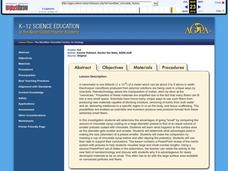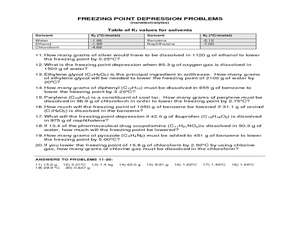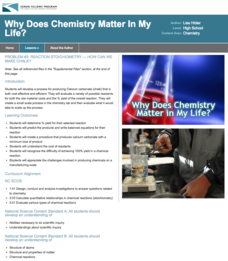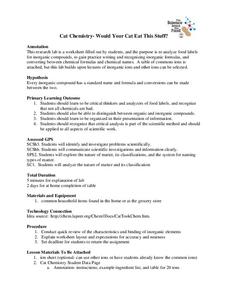Curated OER
Classification of Matter
Students classify items according to their physical properties. In this chemistry lesson, students define what matter is in their own words. They use the matter diagram to organize different substances.
Curated OER
Exploring the Physical and Chemical Properties of Polymers
Students determine the physical and chemical properties of polymers. For this chemistry lesson, students test them for biodegradability. They collect data and compare their results.
Curated OER
Heat Loss and Gain in Physical Changes and Chemical Reactions
Students compare and contrast exothermic and endothermic reactions. In this chemistry lesson, students perform experiments to determine whether heat was released or absorbed in a reaction. They share their observations in class.
Curated OER
How Are Polymers Utilized in Everyday Life?
Pupils identify the different types of polymers. In this chemistry lesson, students research information about an area of polymer science they chose. They create a PowerPoint presentation to share their findings in class.
Curated OER
Mystery Powders
Students describe the physical properties of polymers. In this chemistry activity, students experiment on different polymer powders and identify each one of them. They record their observations and share them to class.
Curated OER
The Nanofiber Chocolate Factory: An Analogy
Young scholars discuss the advantage of using nanotechnologies. In this chemistry lesson, students mass the pretzels before and after dipping them in chocolate. They collect data and compare results in class.
Curated OER
Nanofibers: Why Go Small?
Students explain the advantages of nanotechnology. In this chemistry lesson plan, students investigate pretzels' average diameter and circumference. They graph their result and compare with other groups.
Curated OER
One Plus One Makes New
Young scholars identify the different properties of matter. In this chemistry lesson, students design an experiment on a property of matter they would like to investigate. They report their findings in class.
Curated OER
Plastics and Rubber: What's the Difference?
Students classify household items into either plastic or rubber. In this chemistry lesson, students justify their classification system. They explain the difference between observation and inference.
Curated OER
Study the Fizz
Young scholars hypothesize about the amount of carbon dioxide in soda bottles. In this chemistry activity, students design an experiment to solve the problem. They share findings in class.
Curated OER
Where Did the Water Go? An Investigation in Scientific Methods
Students hypothesize what happened to the missing water. For this chemistry lesson, students test their hypothesis by designing an experiment. They record observations and report findings to class.
Curated OER
You Are What You Eat!
Students calculate the calorie content of food. In this chemistry lesson, students plan a healthy meal based on RDA. They devise an exercise to burn extra calories.
National Renewable Energy Laboratory
Biomass: Biogas Generator
It's a gas. Middle schoolers build a biogas generator following the directions in this resource. After a few days of observation, they demonstrate that the gas given off by the decomposing manure is flammable. The activity concludes as...
Curated OER
Ice Cream Lab
This very thorough lesson plan has learners collect all ingredients necessary and work in pairs to make ice cream using plastic bags. They take temperature readings and record them on the chart as well as record findings on the...
Curated OER
Periodic Webquest
Sixth graders explore the periodic table of elements. Using given websites, 6th graders explore the history of the periodic table and its design. Students role play, writing a journal entry, as if they were the author of the periodic table.
Curated OER
Anatomy of an Element
Learners discuss matter and atoms using this resource. First, they look at a website describing atoms. Then, they learn about the periodic table and discuss how it is organized. Finally, they create a comic strip to display their...
Curated OER
Boiling Point Elevation Problems
A table of the ebullioscopic constants for several compounds is found at the top of the worksheet. Using these constants, boiling point elevation can be calculated for the combinations of compounds. This worksheet has the answers along...
Massachusetts Institute of Technology
Lego Atoms and Molecules: Chemical Reactions
Show young chemists what a chemical reaction looks like with two parts of a hands-on experiment. First, learners conduct a wet lab where they observe the reactants (baking soda and calcium chloride, with phenolsulfonphthalein)...
American Chemical Society
The Discovery of Fullerenes
Carbon is the most common element on earth, so the innovative discovery of a new type of carbon molecule won the 1996 Nobel Prize. In the ready-to-go lesson, scholars learn about C60 and how it has opened up the entire area of...
Kenan Fellows
Reaction Stoichiometry—How Can We Make Chalk?
What is a reasonable percent yield in the manufacturing process? Scholars develop a process for producing chalk in the third instructional activity of a six-part series. Then, they must determine the theoretical and percent yield....
Florida International University
Are You Concentrating?
Explore the importance of a concentration gradient in the rates of dissolution. Using the ocean ecosystem, learners study rates of dissolution around coral reefs. A hands-on experiment helps individuals discover the effects of changing a...
SRI International
Science of Water
Water is crucial to survival. Scholars gain an appreciation for water by reading about it, learning about its atomic properties, and investigating its properties through six stations in a lab activity.
University of Georgia
Would Your Cat Eat This Stuff?
Processed foods use inorganic compounds for flavoring and preservation. This take-home laboratory challenges scholars to find 20 different compounds identified on the labels of foods to list on their data collection sheet. The activity...
Teach Engineering
Density and Miscibility
The liquids did not mix — so what do density columns have to do with it? The seventh part in a series of nine provides the theoretical explanation of why density columns do not mix. The lesson covers the topics related to...
Other popular searches
- Organic Chemistry
- Chemistry Chemical Reactions
- Chemistry Periodic Table
- Chemistry Equations
- Chemistry of Life
- History of Chemistry
- Chemistry Lesson Plans
- Organic Chemistry Projects
- Food Chemistry
- Chemistry Current Events
- Chemistry of Soap
- Water Chemistry























